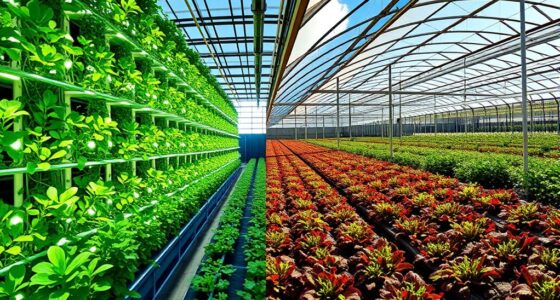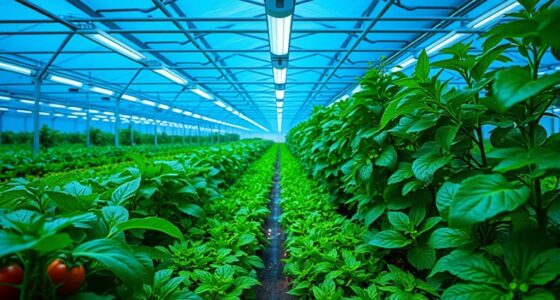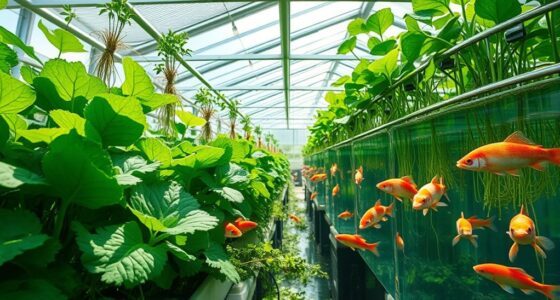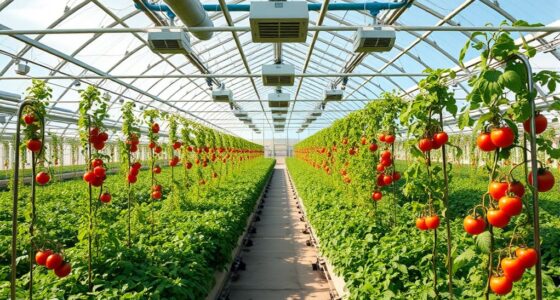In greenhouse pest management, you can use natural and chemical-free methods to protect your plants. Start by maintaining cleanliness through regular sanitation and monitoring to catch issues early. Implement ventilation strategies, efficient water management, and natural barriers to deter pests. You can also release beneficial insects and create homemade pest sprays using natural ingredients. By taking these steps, you'll guarantee your plants thrive without harsh chemicals, and there's plenty more to discover on effective techniques.
Key Takeaways
- Implement companion planting to attract beneficial insects and deter harmful pests without using chemicals.
- Utilize natural barriers and traps, such as diatomaceous earth and sticky traps, to effectively manage pest populations.
- Release predatory insects like ladybugs and predatory mites to control pest numbers biologically.
- Maintain cleanliness and regular monitoring to detect pest issues early and prevent infestations.
- Create an efficient drainage system and optimize water management to reduce pest habitats and promote healthy plant growth.
Understanding Common Greenhouse Pests

When it comes to greenhouse gardening, understanding common pests is essential for maintaining healthy plants.
You'll often encounter aphids, small insects that distort leaves and stunt growth by sucking sap. Effective communication and timely intervention can help prevent these pests from overwhelming your greenhouse. Additionally, high dietary fiber in chia seeds can promote gut health, which may help gardeners manage stress levels associated with pest infestations. Using hydrocolloid technology can also aid in healing for any skin irritations that arise from gardening.
Whiteflies, powdery and white, can yellow leaves and cause drop.
Fungus gnats thrive in moist soil, with larvae damaging plant roots.
You might also spot mealybugs, which have a waxy coating and lead to stunted growth.
Finally, spider mites, tiny and eight-legged, create webs and cause yellowing. Many pests are small, difficult to spot early, and can cause significant harm if not managed promptly. Identifying these pests early helps you take action before they wreak havoc on your greenhouse.
The Importance of Cleanliness in Pest Management

Maintaining cleanliness in your greenhouse is absolutely vital for effective pest management. Regular sanitation reduces pest habitats and breeding grounds, minimizing infestations. By cleaning tools and equipment, you prevent the transfer of pests between areas, ensuring a healthier environment. When you keep things tidy, it becomes easier to monitor and detect pest issues early. Removing plant debris and weeds eliminates potential sites for pests and diseases; daily disposal of organic waste prevents pests from migrating back. Additionally, disinfecting surfaces and tools after each use is essential to avoid cross-contamination. Understanding the importance of financial planning during pest management can also aid in sustaining a healthier ecosystem. Furthermore, implementing digital literacy programs can help greenhouse staff effectively communicate about pest management strategies. Finally, restricting access to necessary personnel and ensuring they maintain hygiene further reduces contamination risk, creating a balanced ecosystem that supports your pest management efforts. This proactive approach not only promotes reduced pest populations but also contributes to the overall health of your crops. A clean environment also enhances property value and encourages a more productive setting for plant growth.
Effective Monitoring Techniques for Early Detection

Keeping a clean greenhouse sets the stage for effective pest management, but it's equally important to monitor your plants closely for early signs of infestations.
Regular inspections, ideally weekly or twice-weekly, allow you to catch problems before they escalate. Use systematic and random scouting methods to thoroughly check all plants, including those in hanging baskets. Additionally, consider the use of indicator plants as they can provide early warnings about pest issues. Implementing budget-friendly maintenance plans for your greenhouse can also help ensure that your plants remain healthy and resilient against pests. Diverse tent camping locations in New England, for example, can inspire creative ways to utilize natural pest deterrents.
Sticky traps placed in a grid pattern help monitor flying pests; yellow traps attract general pests while blue traps target thrips. Incorporate indicator plants, like marigolds for spider mites, to detect issues early.
Remember to maintain detailed records of pest sightings and management actions, as this information is invaluable for tracking trends and refining your strategies over time. Effective crop monitoring is the foundation of your pest management efforts, ensuring timely pest control and reducing unnecessary pesticide applications.
Ventilation Strategies for Pest Control
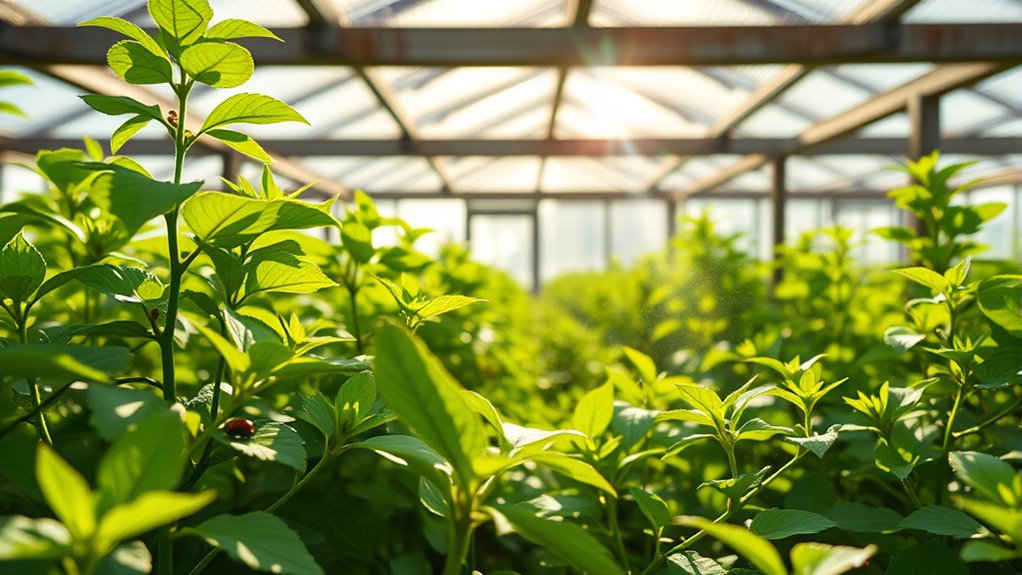
Effective ventilation strategies are essential for maintaining a healthy greenhouse environment and controlling pest populations.
Utilize fan and pad systems to cool your greenhouse while preventing pests from entering through airlock entrances. Install fine-mesh screens over all ventilation openings to exclude small insects like whiteflies and thrips, and consider using UV-protected materials for durability. Maintaining a clean exterior greenhouse area free of weeds and pest-harboring plants is also vital for pest management. Proper ventilation not only aids in temperature control but also creates an environment that encourages natural pest predators to thrive. Additionally, using educational toys to teach children about pest management can foster a deeper understanding of the ecosystem. Introducing solar panels for camping can also provide a sustainable energy source for your ventilation systems.
Maintain positive air pressure to deter pests from sneaking in through vents and doors. Regularly monitor and clean your ventilation systems to guarantee peak airflow and pest prevention.
By increasing the ventilation area and incorporating oscillating fans, you can enhance air circulation, further reducing pest habitats.
Combining these ventilation strategies with other pest control methods will improve your overall effectiveness.
Water Management Practices to Deter Pests
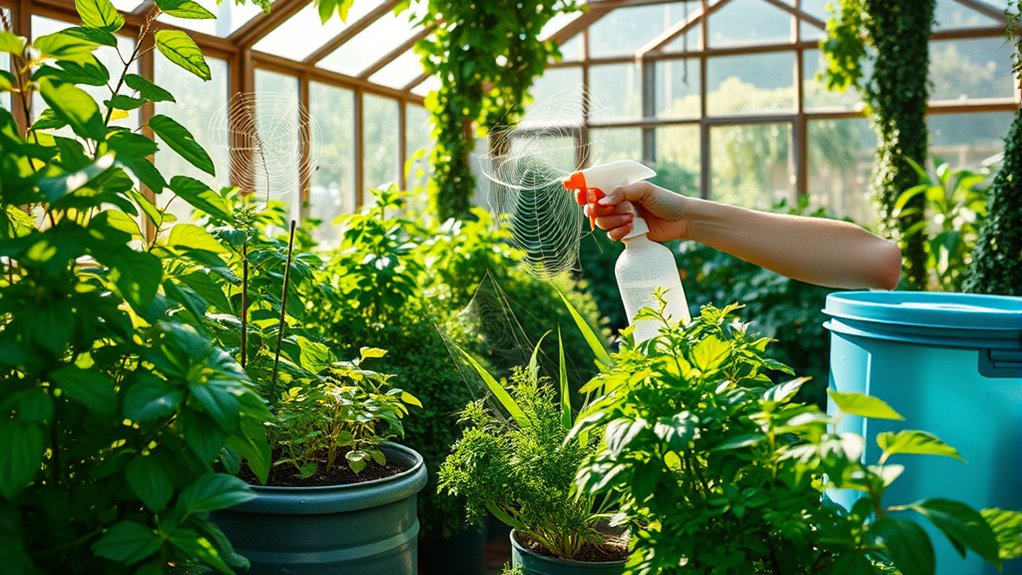
When you implement smart water management practices in your greenhouse, you can greatly reduce pest problems.
Using efficient irrigation systems, like drip irrigation, minimizes excess water that attracts pests such as fungus gnats. Regularly recycling drain water helps maintain nutrient balance and reduces waste.
Efficient irrigation systems, like drip irrigation, reduce excess water, minimizing pests and maintaining nutrient balance.
By optimizing irrigation schedules based on plant needs and allowing dry-down periods, you prevent overwatering and create conditions less favorable for pests. Collecting rainwater also lowers reliance on contaminated sources that can harbor pests. Additionally, maintaining optimal moisture levels is crucial for deterring pest populations. Implementing regular inspections of your irrigation system can further ensure that it operates efficiently and effectively. For example, monitoring solar panel orientation can also help create microclimates that deter pests.
Regular water quality testing, along with appropriate disinfection methods, guarantees your water remains safe for plants.
Finally, efficient drainage systems and proper substrate design keep moisture levels in check, reducing pest habitats and promoting healthier plants overall.
Utilizing Companion Planting for Natural Pest Resistance
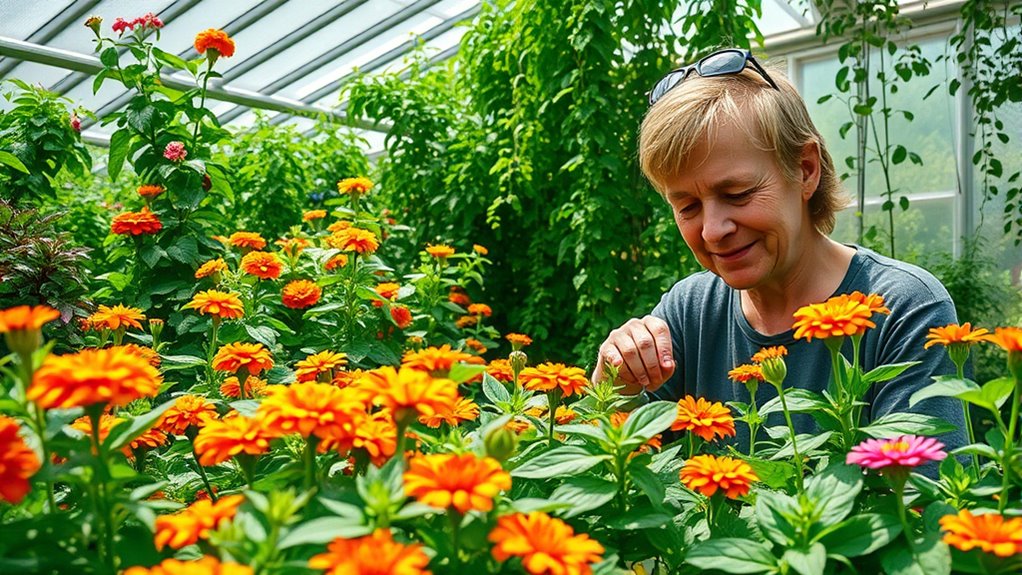
Smart water management practices can set the stage for a thriving greenhouse, but pairing those methods with companion planting takes pest control to another level.
By planting diverse crops together, you create habitats for beneficial insects while confusing harmful pests. For instance, marigolds can repel nematodes and attract pollinators, while garlic and chives deter aphids and beetles. This increased plant diversity leads to fewer pests in the garden and a healthier ecosystem. Additionally, incorporating educational toys in children's play can enhance their understanding of natural ecosystems through hands-on learning experiences. Furthermore, using unique planter designs, such as vertical planters, can optimize space and encourage a variety of plant pairings. Plants that attract pollinators are essential for maintaining a balanced ecosystem in your greenhouse.
You can also use trap crops like nasturtiums to lure pests away from your main crops. Additionally, pairings such as tomatoes with basil not only attract beneficial insects but also boost each other's growth.
Embracing companion planting reduces your reliance on chemical pesticides, enhances pollination, and promotes healthier soil, leading to a more resilient greenhouse ecosystem.
Natural Barriers and Traps for Pest Control
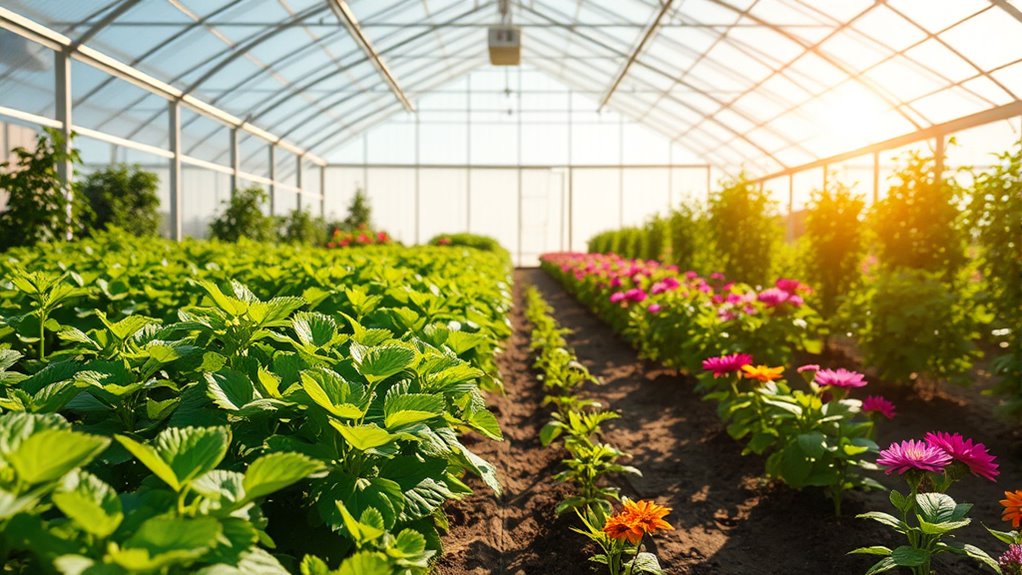
Natural barriers and traps are essential tools for maintaining a pest-free greenhouse environment. You can use physical barriers like screens and hardware cloth to keep pests out while ensuring proper ventilation. Incorporating coffee grounds and eggshells around your plants can deter slugs and snails due to their rough texture. Diatomaceous earth is effective for dehydrating pests, while floating row covers protect young plants from harm. Additionally, healthy soil creates stronger plants that are better able to withstand pest pressures. Implementing integrated pest management (IPM) strategies can further enhance your pest control efforts by promoting natural pest control methods. For instance, using omega-3 rich seeds in your greenhouse can help attract beneficial insects that naturally control pest populations. Another effective barrier method is using organic mulch, which can reduce weed growth and provide habitat for beneficial organisms. For traps, sticky traps work wonders on whiteflies and ants, and beer traps attract pesky pill bugs. Regular inspections and good sanitation practices enhance these methods, creating an effective pest management plan.
Implementing Biological Controls in the Greenhouse

Implementing biological controls in your greenhouse offers a powerful complement to the natural barriers and traps you've already set up.
Start by introducing predatory insects like ladybugs and lacewings to tackle aphids. Parasitic insects, such as Aphidius colemani, can help reduce aphid populations effectively. Additionally, the holistic approach emphasizes the importance of maintaining overall ecosystem health in your greenhouse, which can also help mitigate emotional volatility during pest management. Understanding the role of predatory insects is crucial for successful biological control strategies.
Consider predatory mites like Phytoseiulus persimilis for spider mite control. Beneficial nematodes work wonders against soil-dwelling pests like fungus gnats. Biological control does not entirely eliminate target pests, but it can be a primary pest management method.
Timing is essential; release these agents before pest populations spike, ideally in moderate temperatures during mornings or evenings.
Regularly inspect your plants to monitor both pests and beneficial insects, ensuring you maintain a balanced ecosystem.
With patience and careful planning, biological controls can greatly contribute to a healthier greenhouse environment.
Homemade Pest Sprays: Recipes and Uses
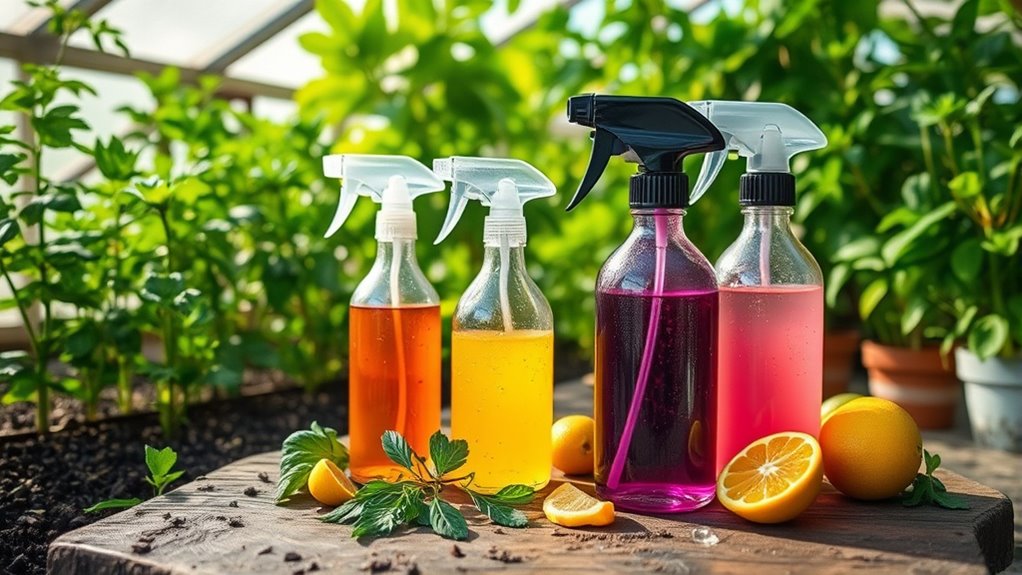
Homemade pest sprays offer an effective and eco-friendly way to protect your greenhouse plants from unwanted pests. You can easily create these sprays using natural ingredients like garlic, mint, and cayenne pepper, which repel various pests without harming beneficial insects. For a simple garlic-mint spray, blend garlic and mint, boil with water and cayenne, then strain and add a bit of biodegradable soap. The garlic-mint spray has shown positive results in recovering damaged plants and promoting new growth, especially when used in conjunction with organic cultivation methods. Store your homemade concoctions in the fridge to maintain potency, and apply them on cloudy days to prevent leaf burn. Remember to reapply every few days or after rain. With these cost-effective and customizable recipes, you'll keep your greenhouse thriving while reducing your environmental impact.
Record Keeping for Effective Pest Management
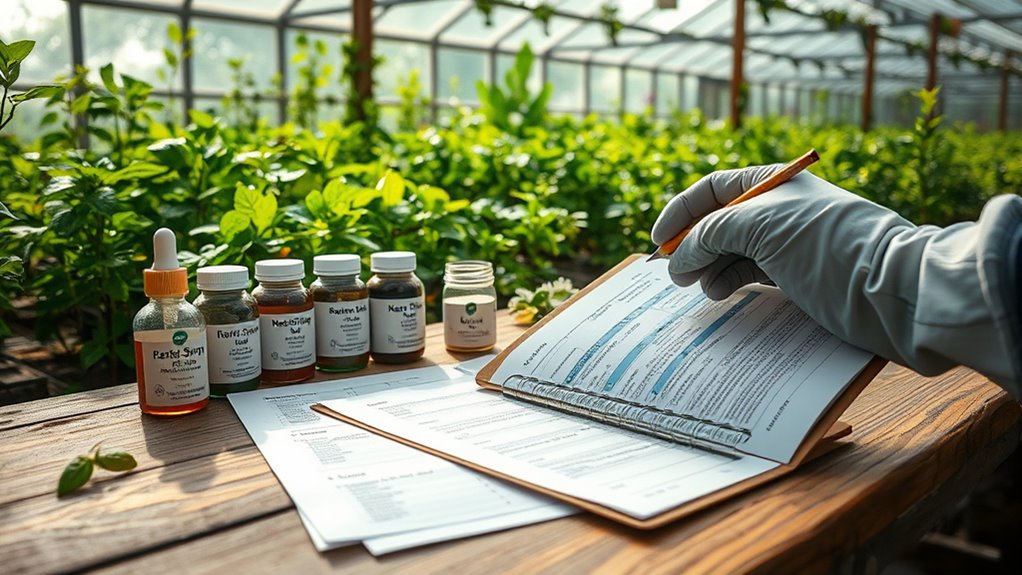
While managing pests in your greenhouse, keeping detailed records can greatly enhance your effectiveness. Accurate record-keeping helps you track pest populations, treatment effectiveness, and identify infestation sources. Include pest numbers, locations, and species to monitor trends, determining if populations are increasing or decreasing. Use pest monitoring records from sticky traps and plant inspections, as well as pesticide application logs for compliance. Additionally, regular inspection and monitoring can provide critical data to improve your pest management strategies. Document plant health and treatment success to evaluate your strategies over time. Consider digital systems for efficient data management, ensuring records are consistent, accurate, and accessible.
Frequently Asked Questions
What Are the Signs of a Pest Infestation in My Greenhouse?
If you notice sticky substances on leaves or surfaces, that's a sign of pest infestation.
Look for yellowing or curling leaves, which indicate damage from pests like aphids and spider mites. Fine webbing between stems suggests spider mites are present.
Keep an eye out for flying insects such as whiteflies and fungus gnats.
Finally, if your plants show signs of wilting or stunted growth, it's time to investigate further.
How Do I Identify Beneficial Insects From Harmful Pests?
To identify beneficial insects from harmful pests, start by observing their behavior and appearance.
Beneficials like ladybugs and lacewings actively hunt pests, while harmful ones like aphids and spider mites damage plants.
Look for distinct features: beneficials often have vibrant colors and unique body shapes.
Additionally, beneficials usually cluster around pest populations, helping to control them.
Regular monitoring will help you distinguish between the two and maintain a healthy ecosystem in your greenhouse.
Can I Use Essential Oils for Pest Management?
Did you know that essential oils can reduce pest populations by up to 90% when used correctly? You can definitely use essential oils for pest management.
Oils like peppermint and neem repel or kill pests on contact. Simply mix them with water and spray them on your plants.
Remember to apply regularly for the best results and keep an eye on concentrations to protect beneficial insects.
It's a natural, effective way to manage pests!
What Are the Environmental Impacts of Chemical Pest Control?
Chemical pest control can greatly harm the environment. You might find that these chemicals contaminate soil and water, disrupting ecosystems and harming beneficial insects.
Air quality can suffer, as pesticide particles drift beyond their intended areas. Over time, repeated use can degrade soil fertility and lead to resistant pest populations.
Additionally, the risks to wildlife and human health from residues can create long-lasting impacts, making it essential to contemplate sustainable alternatives.
How Often Should I Apply Homemade Pest Sprays?
Think of your plants as delicate dancers in a garden ballet; keeping them pest-free is essential for their performance.
You should apply homemade pest sprays every few days, especially for contact-based solutions like chili garlic spray. Weather plays a role too; rain can wash away your efforts.
Keep an eye on pest severity and plant sensitivity to adjust your schedule, ensuring your green beauties stay healthy and vibrant.
Conclusion
Incorporating integrated pest management strategies can greatly safeguard your greenhouse. By staying vigilant and utilizing cleanliness, effective monitoring, and natural barriers, you're setting the stage for success. Remember, every detail counts—diligently document your efforts and embrace eco-friendly solutions like homemade sprays and biological controls. With a proactive approach, you'll create a thriving, pest-free paradise. So, stay sharp and seek sustainable methods to cultivate your green haven, ensuring flourishing plants and fruitful harvests for seasons to come!



